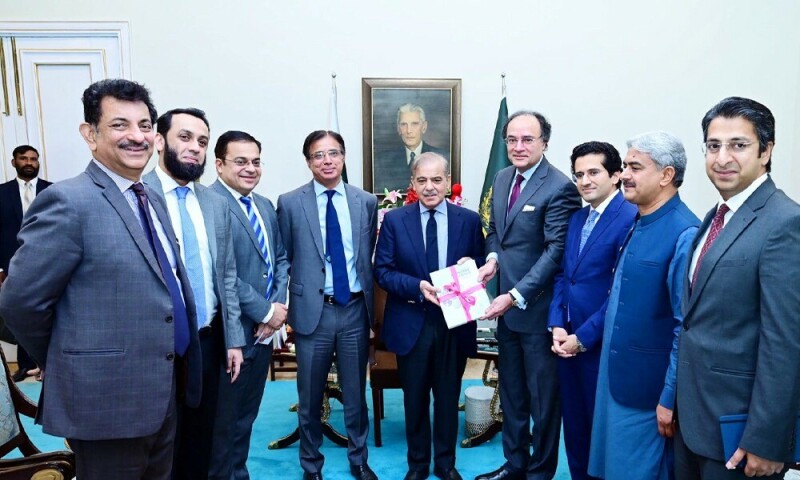Finance Minister Muhammad Aurangzeb unveiled the Pakistan Economic Survey 2023-24 on Tuesday, recapping the annual report on the country’s economic progress for the outgoing financial year.
With 2.38% growth (July-March) in FY2023-24 against a contraction of 0.2% in FY2022-23 and inflation reading at 24.5% in July-May of the FY24, Aurangzeb said Pakistan will manage external debt in FY25 similar to its pattern adopted in the outgoing fiscal.
Business Recorder presents major highlights of the document that is mostly based on July-March of FY24 figures.
-
Real GDP grew by 2.38% in FY24, reversing the negative growth of 0.2% in FY23 on prudent policy management, resumed inflows from partners, and recovery in major trading partners.
-
The key driver of economic growth in FY24 was the agriculture sector, which grew the most in 19 years, according to the survey. The sector grew by 6.25% in FY24, driven by 16.82% growth in key crops like wheat, rice, and cotton.
-
Industrial sector grew by 1.21% in FY24, with manufacturing up by 2.42% and construction by 5.86%.
-
Services sector, making up 57.7% of GDP in FY24, experienced a moderate growth of 1.21%.
-
GDP at current market prices increased by 26.4% to Rs106 trillion in FY24, up from Rs84 trillion last year.
-
Per capita income rose by $129 to $1,680, due to increased economic activity and exchange rate appreciation.
-
Investment-to-GDP ratio fell to 13.14% in FY24 from 14.13% in FY23, mainly due to contractionary macroeconomic policies and political uncertainty.
-
Saving-to-GDP ratio was 13% in FY24, slightly down from 13.2% in FY23.
-
Growth of the automobile sector plunged by 37.4% against a contraction of 42.2% last year.
-
Pharmaceuticals witnessed encouraging growth of 23.2%, against a contraction of 23.1% last year.
-
Food group imports declined by 14.2%. The group’s imports dropped to $6.3 billion.
The government is focused on maintaining a stable economy by prioritising exports and investment. Through continued policy and reform implementation, growth is anticipated to reach its medium-term potential of 5.5% by FY 2027 gradually. – Economic Survey 2023-24
-
Pakistan’s headline inflation Consumer Price Index (CPI) averaged at 24.52% during July-May in FY24. In FY2022-23, CPI stood at 29.2%.
-
Current account deficit (CAD) shrank by 94.8% to $200 million in July-April, compared to $3.9 billion during the same period last year.
-
Trade deficit in goods decreased by 21.6% to $17.7 billion in July-April from $22.6 billion last year amid a significant decline in imports.
-
Primary income account deficit rose by 34.8% to $6.1 billion in July-April, compared to $4.6 billion last year, driven by higher dividend repatriation and interest payments.
-
Remittances experienced a 3% year-on-year (YoY) decline, totaling $23.9 billion during July-April.
-
Financial account saw net inflows of $3.9 billion in July-April, mainly due to inflows from the International Monetary Fund (IMF)’s Stand-by Arrangement (SBA) and friendly countries, compared to outflows of $0.6 billion last year.
-
Foreign Direct Investment (FDI) inflows increased by 8.1% to $1.5 billion in July-April, compared to $1.3 billion in the same period last year.
-
Pakistan rupee appreciated by nearly 3.0% during the first eleven months of FY24 against the US dollar.
-
Total public debt stood at Rs67.5 trillion by end-March 24. Domestic debt was recorded at Rs43.4 trillion while external debt reached Rs24.1 trillion ($86.7bn).
-
With high revenue collection of Rs9.8 trillion (41% higher YoY), fiscal deficit was contained at 3.7% of GDP against the last year same period’s deficit of 3.6%.
-
Total expenditures during grew by 37% to Rs13.7 trillion (Rs10.1 trillion in same period last year) mainly on account of 33% higher current expenditure (Rs12.3 trillion).
-
Primary Balance posted a surplus of Rs1,615 billion against a deficit of Rs503.8 billion.
-
Tax collection grew by 29% while non-tax revenues increased by 91%. However, for July-May, the Federal Board of Revenue (FBR) revenue collection stood at Rs8.1 trillion.
Read the full story at the Business Recorder - Latest News website.



